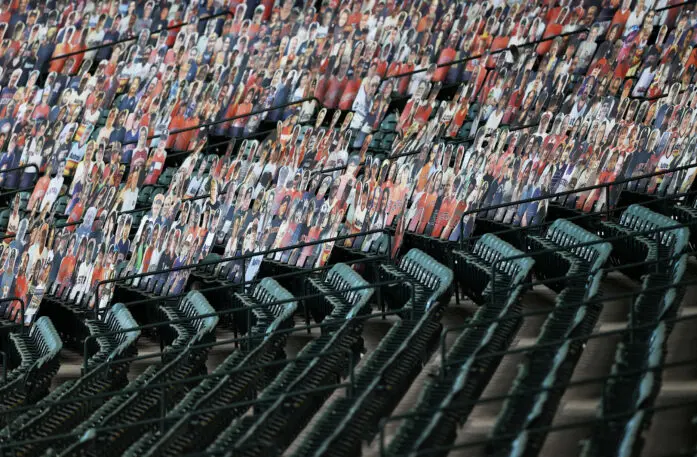For Fast Company’s Shape of Tomorrow series, we’re asking business leaders to share their inside perspective on how the COVID-19 era is transforming their industries. Here’s what’s been lost—and what could be gained—in the new world order.
Last spring, the COVID-19 pandemic halted all major sports. Even when games restarted, they were significantly altered. Major League Baseball’s usual 162-game season was pared down to 60 games, which were played in empty stadiums. This year, baseball is back with a full schedule, and games will be played in front of fans, starting at reduced stadium capacities. As Opening Day 2021 kicks off, MLB chief operations and strategy officer Chris Marinak talks to Fast Company about how fan engagement has changed during the COVID-19 era, and what the league is doing to adapt for the future.
Fast Company: What have been some of the most significant lessons that you learned from last year, and how did you apply them to this new season?
Chris Marinak: What we learned—and we sort of knew this intuitively, but [this past year] reinforced it—was that the game of baseball is a connection vehicle for people, it brings people together.
Even if you can’t come to the ballpark and sit next to someone, our fans have adapted to using digital tools to re-create that experience. That’s a powerful insight. We’re not just building tools to show the game so you can watch by yourself and consume on your own. We’re building tools, products, and a digital ecosystem that allows our fans to connect with each other. Whether that’s watching together, or playing a game around the game together, or watching and sharing highlights.
This season, everything we do on our digital properties and fan engagement platforms is about adding connection opportunities for fans so they can share and interact with friends and family.
What are some examples of that?
Right when the pandemic hit last year, we decided to invest in this little feature within our app that allows fans to log into the game and cheer along with it. When something happens, you can clap or cheer, and that would get piped back into the scoreboard room at the field. The scoreboard operator can see what’s being submitted and use that to augment the virtual crowd noise in the stadium. We thought it was a cool little gimmick and didn’t spend a lot of time on it. We thought people might try it once or twice and then it would fade away a bit. But it had something like 90 million interactions on it. People just loved to feel like they were part of the game. That was a great learning experience for us, and something we’ll still have this year, even though there will be fans starting to come back to the ballpark.
Something a bit more elaborate is the Rally game, which is a way for us to create a game within a game. People can log in, follow the game, try to predict what’s going to happen, score points, and redeem those points for merchandise. We got a lot of engagement on that. It was a big success for us. In terms of driving new subscriptions and user accounts, the average age was 32. Our average age across the rest of our portfolio is 40s and early 50s. It was close to 20 years younger than what we see on our traditional platforms. This year we’re doubling down on that, creating leaderboards and ways to pick friends to make a fantasy-type group for people to play with.
Another example is Film Room [launched late last season], where we’re democratizing access to highlights. We’re moving [away] from a world where we felt we had to provide and curate all the highlights for our fans, whether it was on a traditional linear media platform or on our website. And we were very controlling about who had access to our highlights. We’ve now done a 180 and said, instead of being so controlling, why not make the whole thing available? Give fans what they’re asking for, then give them the keys to search for whatever they want to create their own highlight reels. It goes back to that idea that people like to share these things with their social communities, and it builds this bond and interaction around the game, and we think it gets people more entrenched in the sport.

The big thing we’re looking at is the way we deliver the viewing experience. Linear television obviously has a lot of benefits— it’s reliable, it has good picture quality. But the benefit of the digital platform is that it allows for a lot of other capabilities. We are spending a lot of time looking at how we do co-viewing, creating watch groups and chats, and there are a lot of tech partners we’re experimenting with behind the scenes.
We want to use AI and machine learning to understand who you are and what’s interesting to you. Then it’s not, ‘Pick your game, how long do you want to watch?’ It’s ‘Press play, and we’ll take you to your favorite team.’ [You can] watch that game, and if that game becomes a blowout or goes to commercial, we’ll take you to your favorite player. Or if there’s a really important situation, late in the game, bases loaded, for a team in your division that may impact you in the playoff race, we flip there. So it’s [about giving] you this unique angle toward consuming our content and feeling like you’re on your own customized journey.
The Texas Rangers are aiming to be the first U.S. sports team to be back at full stadium capacity for their home opener, which is against the Blue Jays on April 5. From a league perspective, how will you be watching that, and what will you be hoping to glean from it?
That will be an interesting experiment. It remains to be seen if they’re really going to be at 100%. They’ll certainly try to get a good number of people in there, and we’ll see how that goes. The good thing about all of this is that we’re not going from 0 to 60 overnight. We have a chance to ramp up gradually and learn a bit, especially in markets where there is still more transmission or positive tests. We can apply what we learn in Texas, about things like seat access and washroom access, across the industry. Not everyone is playing on Opening Day. Some of the lessons will be valuable to the rest of the teams, and throughout the season.
More from Fast Company’s Shape of Tomorrow series:
- NASA’s culture chief reveals how COVID-19 altered the agency
- Insiders at General Mills and elsewhere on how COVID-19 changed manufacturing and supply chains around the world
- Atlanta Hawks CEO Steve Koonin on how COVID-19 is changing basketball
- Is advertising really dead? Reports may be exaggerated. Here’s how the leaders of Droga5, TWBA, Wieden+Kennedy, and others are inching forward
- 5 retail experts—from Nike, Athleta, and others—on how stores and brands can survive the COVID-19 era
- Experts predict what it will take to find a job in a post-COVID-19 world
- Insiders at Burning Man, Broadway, Meow Wolf, and others describe how the live-events industry will emerge onto a new stage
- Top executives at the NBA, Major League Soccer, and more on how we’ll experience live sports after COVID-19
- How COVID-19 has changed the way we eat, according to leaders at General Mills, Land O’Lakes, and others
- How the leaders of Barry’s, Orangetheory, and Peloton are bringing fitness classes into people’s homes and rethinking the studio experience entirely
- NHL commissioner Gary Bettman shares lessons from the bubble
Recognize your brand’s excellence by applying to this year’s Brands That Matter Awards before the early-rate deadline, May 3.
